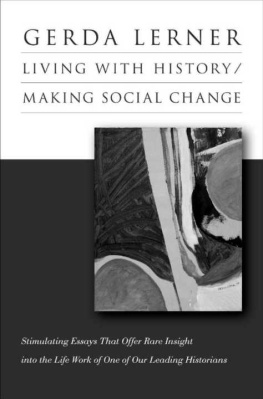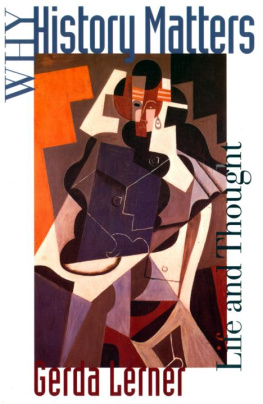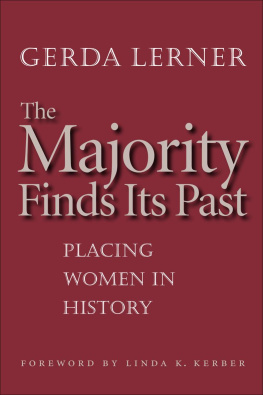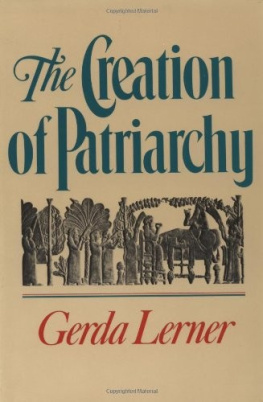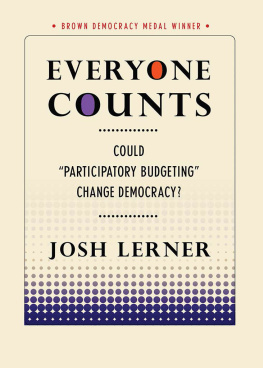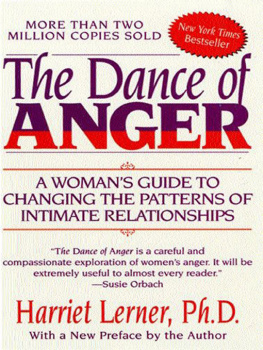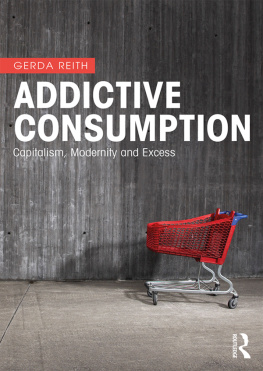Gerda Lerner - Living with History / Making Social Change
Here you can read online Gerda Lerner - Living with History / Making Social Change full text of the book (entire story) in english for free. Download pdf and epub, get meaning, cover and reviews about this ebook. year: 2009, genre: Politics. Description of the work, (preface) as well as reviews are available. Best literature library LitArk.com created for fans of good reading and offers a wide selection of genres:
Romance novel
Science fiction
Adventure
Detective
Science
History
Home and family
Prose
Art
Politics
Computer
Non-fiction
Religion
Business
Children
Humor
Choose a favorite category and find really read worthwhile books. Enjoy immersion in the world of imagination, feel the emotions of the characters or learn something new for yourself, make an fascinating discovery.
- Book:Living with History / Making Social Change
- Author:
- Genre:
- Year:2009
- Rating:5 / 5
- Favourites:Add to favourites
- Your mark:
- 100
- 1
- 2
- 3
- 4
- 5
Living with History / Making Social Change: summary, description and annotation
We offer to read an annotation, description, summary or preface (depends on what the author of the book "Living with History / Making Social Change" wrote himself). If you haven't found the necessary information about the book — write in the comments, we will try to find it.
Living with History / Making Social Change — read online for free the complete book (whole text) full work
Below is the text of the book, divided by pages. System saving the place of the last page read, allows you to conveniently read the book "Living with History / Making Social Change" online for free, without having to search again every time where you left off. Put a bookmark, and you can go to the page where you finished reading at any time.
Font size:
Interval:
Bookmark:


Making Social Change



Making Social Change


vii
I. REDEFINING THE PROFESSION OF HISTORY
II. DOING HISTORY
III. LIVING IN HISTORY
APPENDIX A.
APPENDIX B.
APPENDIX C.
The terms of reference by which African Americans have referred to themselves have changed over the course of history. I have followed the practice of using the designation chosen by the author or by the group in question during a particular historical period (thus: "Negro women's club movement," but "Black Liberation"). According to the same principle I refer to the nineteenth-century "woman's rights movement" and to the twentieth-century "women's rights movement."
African Americans have struggled for over a hundred years to have the term used to designate them capitalized, as are the designations for other ethnic or racial groups (Italian, Spanish, Caucasian). Thus, whenever the noun "Black" is used as a substitute for "African American" or "Negro," it should be spelled with a capital "B." There is some confusion about the spelling of the adjective "black." One can reason both ways-"Black women and Italian women," both designating group adherence, or "black and white women," both designating skin color. I capitalize the noun and lowercase the adjective, but I recognize this is a term in transition.
I also capitalize "Women's History" when it is an academic field, just as I would capitalize English, Physics, Math. When it refers to a specific case ("women's history differs from that of men," or, "we study the history of women"), it is lowercased.
In English, capitalization has always been used to indicate high or honorific status. When dealing with long-neglected subject groups, the choice of spelling cannot be arbitrary or accidental. It must reflect the historical context, even if it questions traditional usage.

Making Social Change


At this time, when I look back on my life and my work, I see patterns and connections that were not so clearly visible at an earlier stage of my life. The impact of outside political and social events that I experienced in childhood and as a teenager shaped my connection to history: I was a victim of terror and persecution; my life was deeply affected by historical events. As a witness to terrible events, I early learned that history matters. On the other side, a childhood in which artistic creativity and expression were cherished and in which learning was considered not only a practical means of career building, but a means of finding equilibrium and meaning in life well equipped me for survival as a refugee. The life of learning and thinking would always be connected for me with teaching others and with finding a way of applying what I knew to the problems in society.
This book combines essays written over a period of several decades that touch upon the highlights of my practical work as a teacher and as an agent of social change in and out of the academy, and others, recently written, that focus on some of my main concerns as a historian and a political thinker. In this book I want to show how thought and action have been connected in my life; how the life I had led before I became an academic affected the questions I asked as a historian; how the social struggles in which I engaged as an academic woman informed my thinking. I want to explain how a decision to change the content of historical scholarship and knowledge so as to give women just representation became a challenge to develop new teaching methods and to create alternate models of academic discourse. I want to trace how feminist teaching led to the development of "outreach" projects that influenced a large number of people, far beyond the reach of the academy.
Social change is made by strategic analysis and by consistent and continuous organizational work. An adequate strategic analysis -that is, one that can be proven successful by pragmatic application-needs to be based on deep analysis that takes many factors into consideration, and on an understanding of what can be learned from historical precedent. It relies on the building of coalitions and it encourages a lifelong commitment to social action in its participants.
Growing up under a fascist government as a young girl, I wanted to change the world. Antifascism was real to me, a ray of hope in a hopeless environment-it meant democracy, free elections, equal rights for all citizens, freedom of thought. During a short stay in a Nazi jail, from which at the time I had no hope of ever escaping, I learned from my cell mates that political action meant working with others. One could not survive alone.
Later, in America, as an unskilled immigrant worker, I learned firsthand what it meant to be poor and without a support network. I had lived my childhood and adolescence in middle-class comfort; now I was on my own in a labor market in which women were restricted to only the most undesirable jobs. I worked as a domestic, as an office worker, as a salesgirl, and, after a year of training, as a medical technician-always at minimum wages and without job security. During job searches and on the job I experienced discrimination against women-pervasive, sometimes subtle, often open. At times it was mixed with other forms of discrimination. I applied for a job as a switchboard operator at the New York Telephone company. I never made it past the first interviewer. "We don't hire Jewish girls," she informed me. "Why?" "Their arms are too short to reach the switches." That was a new one ...
Jobs were offered in gendered listings -jobs for men, jobs for women. All required previous experience. If you did not have that, you could not get an interview. If you claimed it, you had to provide written references. If you admitted to being an immigrant, you were not considered fit for an interview. It took four months of such hopeless job searches for me to learn that lying was essential. I got my first paid job by lying about my ethnicity, my religion, and my experience and by providing fake references. My employers were Jewish refugees from Vienna, like myself, only they were rich and I was poor. I was required to wear spike-heel shoes and stand on them forty-eight hours a week (sitting down was not allowed), in order to provide an elegant and glamorous look to their 5th Avenue store. With my feet painful and damaged for life, I learned that gender mattered. After a year of working for these employers, I reported them anonymously to the Department of Labor for paying below minimum wages to their factory workers, all of whom were Jewish refugees from Europe. Anony mous or not, I immediately got fired, without a reference. Thus, I learned about class the hard way, and I have never forgotten it. When I became an academic, it was natural for me to consider class and gender as categories of analysis in all my work.
Font size:
Interval:
Bookmark:
Similar books «Living with History / Making Social Change»
Look at similar books to Living with History / Making Social Change. We have selected literature similar in name and meaning in the hope of providing readers with more options to find new, interesting, not yet read works.
Discussion, reviews of the book Living with History / Making Social Change and just readers' own opinions. Leave your comments, write what you think about the work, its meaning or the main characters. Specify what exactly you liked and what you didn't like, and why you think so.

